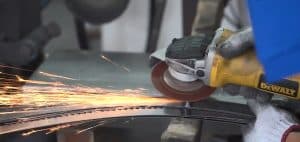Woodworking band saw blades have many professional names about themselves. Today’s article will briefly talk about three of them: pitch, thickness and kerf.
Pitch/TPI – The distance from one tooth tip to the next tooth tip of band saw blades.
Usually measured in teeth per inch (T.P.I.). The larger the teeth, the faster the cutting speed because the teeth have larger gullets and a greater ability to transport large amounts of sawdust on the job.
Generally speaking, the larger the teeth, the rougher the cut and the worse the surface finish of the cut.
But with a DH band saw blade, you get the advantages of fast cuts and a good surface finish.
The smaller the teeth, the slower the cutting speed because the teeth have a smaller gullet and cannot transport large amounts of sawdust during the job. The smaller the teeth, the finer the cut and the better the surface finish of the cut.
If there are fewer teeth engaged, chatter or vibration may result because the work may be over-fed and each tooth will cut too deep. At the same time, sawdust may overfill the tooth’s sockets. Both of these problems can be overcome to a certain extent by adjusting the feed speed. There are some telltale signs if the blade has the correct pitch, or if the pitch is too fine or too coarse.
Correct pitch – the blade cuts fast.
The blade generates minimal heat when cutting. Minimal feed pressure is required. Minimum horsepower required. The blade delivers high-quality cuts for a long time.
Too fine pitch – blade cuts slowly. Too much heat, causing premature breakage or rapid darkening. Unnecessarily high supply pressure is required. Requires unnecessarily high horsepower. Excessive blade wear.
Too coarse pitch – short cutting life of the blade. Excessive tooth wear. The band saw or saw blade is vibrating.
Thickness – Thickness with “spec”.
The thicker the band, the harder the blade and the straighter the cut. The thicker the band, the more likely the blade will break due to stress cracking, and the larger the band saw wheel must be.
If your blade is too thick for the diameter of your wheel, it will break.
Material Hardness – One of the factors you should consider when choosing band saw blades with the proper pitch is the hardness of the material being cut.
The harder the material, the finer the pitch required. For example, exotic hardwoods like ebony and rosewood require finer blades than hardwoods like oak or maple.
Soft woods such as pine will quickly clog the blade and reduce its cutting ability. Multiple tooth configurations with the same width are likely to provide acceptable options for your specific job.
It is important to note, however, that when cutting woods with a high silica content or very hard woods (such as ironwood, ebony, etc.), the blade will dull faster than when cutting soft woods.
Kerf – Width of saw cut of band saw blades.
The larger the slit, the smaller the radius that can be cut. But the greater the amount of wood the blade has to cut, the more horsepower is required because the blade is doing more work. The larger the cut, the greater the amount of wood wasted in cutting.
If you want to know more about woodworking band saw blades, please pay attention to our website. We will update knowledge related to various woodworking tools from time to time.
At the same time, we also provide a variety of products for customers who need woodworking tools. If you are interested in our products, please feel free to contact us or leave us a message.
Band Saw Blade Carbide Tipped Tungsten Carbide Bandsaw Blades


